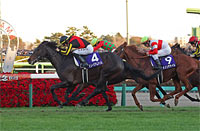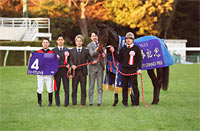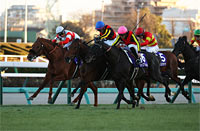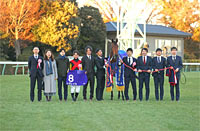Arima Kinen (The Grand Prix) (G1) - Comments from runners' connections

Deep Bond
Deep Bond (horse, 6)
Ryuji Okubo, trainer
“The frontrunner (Panthalassa) in the Japan Cup was fast, but when you consider the entire race, perhaps it wasn’t that fast at all. I think the way the race unfolded, you really had to have speed at the final stage, which wasn’t the kind of race that this horse is good at. He stayed at the training center after that and on Dec. 14 worked on the woodchip course. It was the usual training routine for him. I think he has come along as usual. Last year, the trip to the track took a long time and the race was difficult for him. The year before that, he finished in second place, so I don’t think the course doesn’t suit him. This time he’ll have a different rider (Tom Marquand), so hopefully he’ll be able to bring out something different in him.” |
|

Do Deuce
Do Deuce (colt, 4)
Yasuo Tomomichi, trainer
“For his last race, the Japan Cup, I think he had been able to let off steam in the Tenno Sho (Autumn). He’d been very relaxed in his morning work and I think that really helped him find a nice rhythm in the race, which led to his good results (fourth place). The Tenno Sho (Autumn) was the first race of his autumn campaign. Earlier in the year, he’d traveled to Dubai but had to be withdrawn just before the race. So, this return to racing was a unique one. This horse has been known to get pretty tense. For the Tenno Sho, when Yutaka Take got injured earlier in the day, Keita Tosaki had to suddenly take the ride but it seemed like the jockey was struggling to get along with the horse. For the Japan Cup after that, however, Tosaki did a very good job and I think it was a good race. Take rode work last week and, as I’d thought, they really looked good together. Take said the horse had moved really well as usual. This will be his third start of the fall season but I don’t think he’s tired at all. I’d say he has improved quite a bit and there is no need for more work. Equinox is out of the picture now and I think any horse has a chance. This time, how well he takes those tighter turns of Nakayama is going to be key.” |
|

Harper
Harper (filly, 3)
Yasuo Tomomichi, trainer
“She was able to bring out her strongpoints in the Queen Elizabeth II Cup, but it was tough for her competing against older horses. She’s had four Grade 1 bids since the Grade 3 Queen Cup in the spring and has run well. It’s been a very full year and she has matured a lot. Over one summer, she almost doubled in size. She’s had two starts this fall and there’s no damage. In fact, her weight has gone up. She came back to Ritto looking very filled out and her prep has gone well. Being a filly, she loses weight easily, so I’ve carefully watched that. She worked alone this week, a bit slow to get her engine going, but I had only wanted to see her response in the finish. She looked good, including over the final furlong. As a 3-year-old filly, she carries less weight. She’ll meet her strongest competition so far, but she always gives it 100 percent or even more. I think she’ll do well and will be able to use what she’s learned racing amid her peers as well. She’s easy to ride and I don’t think Nakayama will pose any problems for her. Jockey Mirai Iwata knows her well as he has ridden her several times in training, so that should be a help too.” |
|

Heat on Beat
Heat on Beat (horse, 6)
Yasuo Tomomichi, trainer
“He’s been looking good since winning the Meguro Kinen this spring. He showed his strength in the Copa Republica Argentina and finished third only 0.2 seconds behind the winner even while carrying 59kg. He hadn’t been in bad condition for the previous race (the Kyoto Daishoten) either, but the ground had been a bit soft and that was a factor in his ninth-place finish. On Dec. 14, he worked with two others over the woodchip flat course. He tends to run keeping his head quite high, but in the final stage he did pick it up and gain ground. Even though he always doesn’t look that good in trainings, his footwork was good, and he’s in good shape. I think the relatively short stretch will be a plus as he’ll be able to maintain his concentration for the entire race. The field is strong, but he’s the kind of horse that rises to the level of the others around him. If it’s a fast track, he will definitely run well.” |
|

Ho O Emmy's
Ho O Emmy's (mare, 6)
Masakazu Ikegami, trainer
“After the Fukushima Kinen, she went to the farm for a while and returned to the training center on Dec. 6. Surprisingly, there were no signs at all of the toll the race had on her. She had recovered quickly. She’s been getting pretty hard training, but her partner doesn’t move that well, so her work may have looked even better than it actually was. Everything has gone well, nothing out of the ordinary. Since spring, she’s had two third-place finishes in graded races. In the autumn, she won the Grade 3 Fukushima Kinen. She has really come into her own. This time it’s a Grade 1 and the members are strong. To be able to participate in the Arima Kinen makes the entire stable happy. I’m hoping she’ll will rise to the challenge. This will be her first time over 2,500 meters, but she has done well over 2,200 meters. I think she doesn’t have any particular problems staying in tune with the rider and the inner course suits her too. She’ll be able to handle it.” |
|

Iron Barows
Iron Barows (horse, 6)
Hiroyuki Uemura, trainer
“In the Stayers Stakes, we finally were able to bring out his best. It wasn’t running behind another horse that brought out his fighting spirit, it was taking the lead. The jockey really understood this horse’s temperament and strongpoints. The ride he gave him was a big factor in the win. He won so nicely that I thought if he could travel much the same way in the Arima Kinen, so that’s why I decided to enter him here. He’s a tough horse so I’m not worried about his schedule. From his performance in the Stayers Stakes, I’d say the Nakayama layout suits him. If he can run the same kind of race over 2,500 meters will be key, as there’s the front-running Titleholder in the lineup. If this one can find a nice rhythm, things may go well.” |
|

Justin Palace
Justin Palace (colt, 4)
Haruki Sugiyama, trainer
“In the Tenno Sho (Autum), he was slower out of the gate than usual and wound up racing from further back than I’d expected. In the stretch, however, his footwork and acceleration were better than anything I’d imagined. l saw a new side to him and I think he learned a lot from that race. I don’t think he’s ever clocked 33-some seconds over the final three furlongs. To show that kind of speed indicates how much he has matured. As this is only his second start of the fall, he still has energy to spare. Takeshi Yokoyama rode him last week, working over distance with a strong finish. For his previous race, I’d given him his final work on the flat, but this time, with the long trip to the track, and with the crowd around the paddock, I decided to give him his final workout on the uphill course and be careful not to push him too hard. He’s very laidback mentally, and looking at his work this week and hearing that he was relaxed throughout, I’m satisfied. He had a good run in the Tenno Sho (Autum) with this kind of prep and I’ve taken the same route this time with confidence.” |
|

Lilac
Lilac (filly, 4)
Ikuo Aizawa, trainer
“Looking at the results in the Queen Elizabeth II Cup, those runners that raced on the inside had the advantage. She started well and ran solidly in the stretch, but I wish she had had an inside draw. I kept her at the training center after that and her recovery went smoothly. She’s had hard workouts on the woodchip flat and the uphill course. When jockey Keita Tosaki rode her last week, she ran on the inside so her time was good, but her footwork was also good. She has maintained her weight above 450kg, so she’ll most likely post a gain on raceday. She hasn’t ever lost badly at Nakayama, including her fourth in the Nikkei Sho. She’s matured and seems to be feeling good, so I’m looking forward to the race.” |
|

Pradaria
Pradaria (colt, 4)
Manabu Ikezoe, trainer
“He went to the farm after winning the Kyoto Daishoten and returned to the training center on Nov. 2. Two weeks ago, he’d been easy to ride but then was a bit sour and not wanting to pick up the pace easily. However, last week, working with another horse, he looked to be nearly ready for racing. His time wasn’t that fast but his responses were good. I’d had the jockey push him hard, and when he signaled to up the pace, the horse responded very well. The jockey later said he felt the horse was ready and there was no need to push him harder. After his work, the horse’s breathing was good, and his overall condition is good too. This will be his first time at Nakayama, but looking at his perfect performance in the Kyoto Daishoten, he’s not a horse to give his rider much trouble. So, it being his first time at Nakayama shouldn’t be a problem. He also looks to do well over heavier ground. He’s in good condition, and I think he has a shot at it.” |
|

Shahryar
Shahryar (horse, 5)
Nobuyuki Tashiro, assistant trainer
“The winner in the Breeders’ Cup Turf went up the inside and passed this one, but Shahryar ran very well. After that, we flew to Hong Kong and everything was going well, but after the local authorities assessed the situation, he had to be withdrawn from the race. He returned to Japan on Dec. 12 and went to the JRA Horseracing School for quarantine, then to Nakayama Racecourse. He’s fit and in good condition, so all that was needed was a bit of fine-tuning. It’s his first time at Nakayama, but he has done well on other tight course. The distance isn’t a problem either. He can show his best on a fast track. It’ll be enough to run to his full potential.”
Hideaki Fujiwara, trainer
(after work over the turf at Nakayama Dec. 21)
“He was fantastic. He has maintained the condition he had for Hong Kong. There’s a bit of a gap between races, but today he moved really well and accelerated well as I had expected him to. There are no problems, and he proved that with the way he moved and the condition he’s in.” |
|

Sol Oriens
Sol Oriens (colt, 3)
Takahisa Tezuka, trainer
“He was third in the Kikuka Sho (Japanese St. Leger) and though I think 3,000 meters was just barely within his reach, he also covered a lot more ground on the outside. He came back from the farm looking good and on Dec. 13 worked over the woodchip course with Win Marilyn as his training partner. His time was good and it was a good, hard workout. Recently, he’s putting all he has into his work and he’s able to give whatever we ask of him. Yuga Kawada rode work this week and got a final reading on him. Since Sol Oriens won the Satsuki Sho (Japanese 2000 Guineas) at Nakayama, we know it’s a course where he can get good results. Also, it being after the Kikuka Sho, having the shorter 2,500 meters this time is definitely a plus and he will be able to travel much easier as well. He hasn’t gotten great results this fall, but he’s stronger and in better condition than he was in the spring. I have my hopes up.”
Yuga Kawada, jockey
(After fast trackwork on Dec. 20)
“He had a good workout last week, so the most important things were not overdoing it today, and getting a reading on him. As I had imagined, he’s young in a good way. He’ll no doubt get even better next year, is what I felt.” |
|

Stars on Earth
Stars on Earth (filly, 4)
Mizuki Takayanagi, trainer
“I wasn’t able to race her in the Tenno Sho (Autumn) as planned, so the preparation for the Japan Cup was difficult. Still, she went to the gate in good condition and I think she was able to give it what she has. Afterward, she didn’t seem fatigued at all, but did go to the farm for a bit, then returned to Miho. Last week, jockey Makoto Sugihara, who knows her well, rode fast work and I think she looked good. This week, Christophe Lemaire rode her. Since she’s already ready for racing, it was just a matter of fine-tuning. I must say I think Tokyo Racecourse suits her more than Nakayama, but I’m not worried about the distance. It’s a tricky course and I am a little worried, but she should be able to handle it well enough. She’s mentally very well-balanced and she’s built solidly for a filly. For me ever since I was a child, the Arima Kinen has always been a race I’m infatuated with. To have a contender in the race is a joy.” |
|

Tastiera
Tastiera (colt, 3)
Noriyuki Hori, trainer
“After the Kikuka Sho, he went to the farm, then returned to the training center on Nov. 24. He came back heavier and his appetite was better than it had been before the Kikuka Sho. I think he’s well both physically and mentally as he finished his feed nearly every day. On Dec. 7, he worked alongside another horse. In the stretch, the training partner didn’t stick tight to him, and when he moved ahead, he lost his concentration. So on Dec. 14, I had him work in tight with two others. On Dec. 17, he worked on the uphill course and because he looked like he could improve just a bit more, I decided to train him hard on race week. Ryan Moore was to ride on the 21st, but the horse took priority and I had him work the day before under an assistant. He was in tune with the rider and his responses were good. I thought his breathing could have been a little bit better. However, it was a hard workout and I think he’ll be just right.” |
|

Through Seven Seas
Through Seven Seas (mare, 5)
Tomohito Ozeki, trainer
“In the Arc, perhaps due to the length of time between races, she didn’t start well and ended up racing from behind. On top of that, she wasn’t able to move to the outside in the stretch and finished fourth racing amid the pack. It was a good effort, but I think the results may have been different if she’d been able to travel from a more forward position. She’d been pretty pumped up physically when in France, but lost that after the race. She went to the farm to recover and came back to the training center weighing about 470kg. On Dec. 13, she worked in the center of the track and covered five furlongs in 64-some seconds, a time I’d expected. With her first 2,500-meter race in mind, I had the rider urge her on even past the finish line and she did pick it up even more. At 2,500 meters, the field is going to pass the stands twice and key will be how much in control she’ll be. Since jockey Kenichi Ikezoe will be riding her for the second time, I think he’ll be able to get a good picture of what needs to be done. I have my hopes up because the jockey knows the horse and the race.” |
|

Titleholder
Titleholder (horse, 5)
Toru Kurita, trainer
“The Japan Cup was his first left-handed race in a while and it was his second start after returning from time off. The competition was strong and I had imagined that the race wouldn’t unfold to his liking, but he made a very good effort in the finish. Usually, after back-to-back races, I’d send him to the farm, but this time I didn’t. Jockey Kazuma Harada rode fast work last week and said the horse was quick and light on his feet. He worked to the right, and seemed easy to ride. I could see he was moving well. This week, the main objective was to have jockey Kazuo Yokoyama get a reading on him. They’ve been together for a long time and he knows how good the horse was last year, and that we want to get him there again. He worked with another horse ahead of him, and the jockey urged this one on fairly strongly. I would have liked him to have switched leads a bit faster, but his stride and pitch were close to what they’d been. There are other horses that will want to lead, but we want this horse to run his own race. When he wins, he wins big, but when he loses it’s always like ‘What happened?” He does things you don’t expect him to, in good ways and not so good ways. He’s quite a character.” |
|

Win Marilyn
Win Marilyn (mare, 6)
Takahisa Tezuka, trainer
“She may have looked a bit heavy in the Breeders’ Cup Filly and Mare Turf, but she gave it all she had and finished fourth only 0.2 seconds behind the winner. It was a good race. Since she had to be quarantined after coming back to Japan, her return to the training center was delayed. I had her work long and hard on Dec. 13 over the woodchip flat course with another horse, and it was a good workout. The Arima Kinen is run on the same distance as the Nikkei Sho, which she won. Earlier, we had her race from a good position, but now we let her run at her own pace and move up more slowly and pick it up from there. That seems to be working well. This time Luke Morris will ride her. She’s not particularly difficult in any way. The jockey has also watched her race videos over and over and I think he has a good reading on her.” |
|
Sources: Keiba Book, Radio Nikkei, Nikkan Sports
|

- Preview
- Barrier draw
- Past performances of runners

- News
- Race result
- Video
- 2025 English

- 2024 English

- 2023 English

- 2022 English

- 2021 English

- 2020 English

- 2019 English

- 2018 English

- 2017 English

- 2016 English

- 2015 English

- 2014 English

- 2013 English

- 2012 English

- Photo Gallery
2025 Winner: Museum Mile


2024 Winner: Regaleira


|







